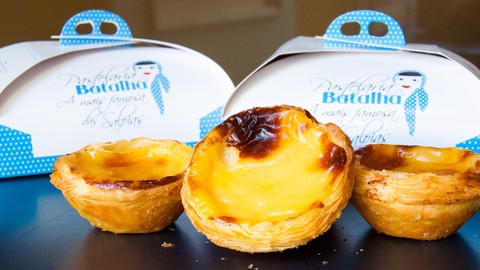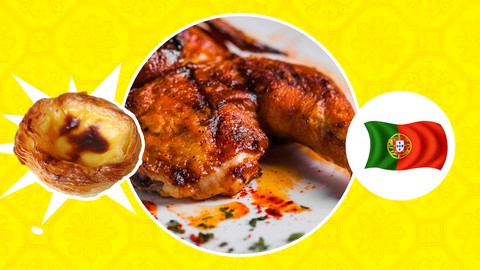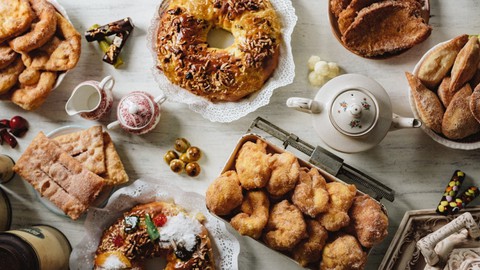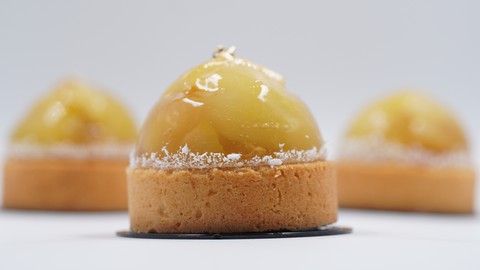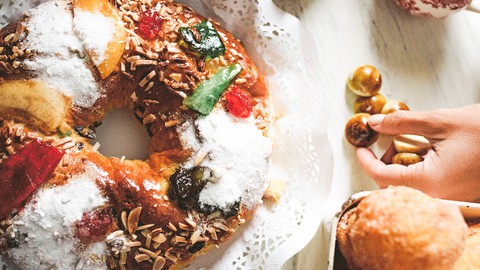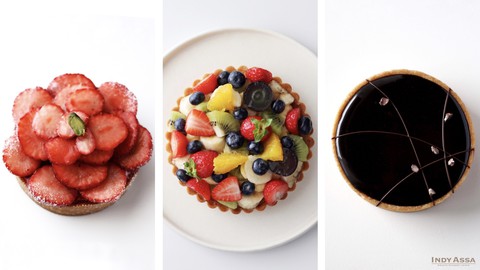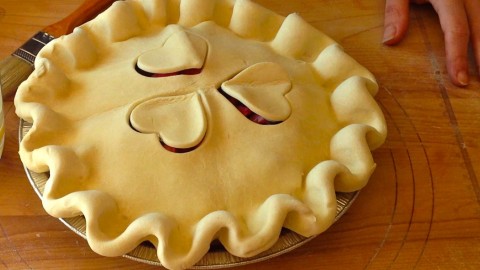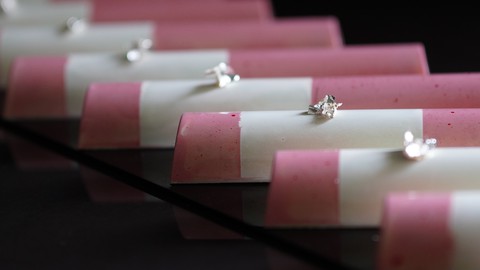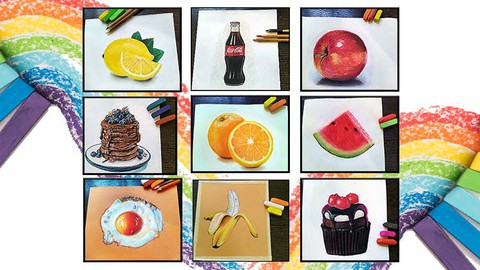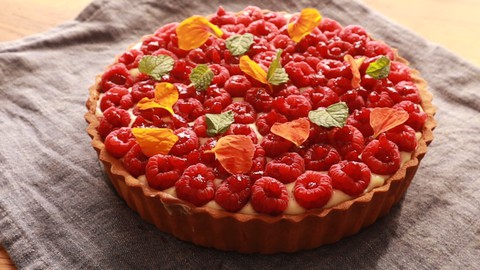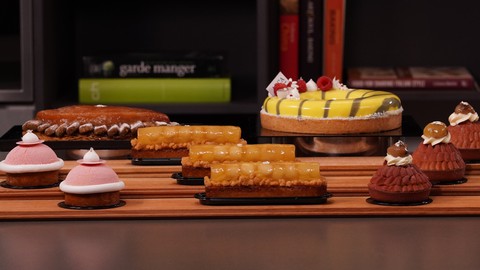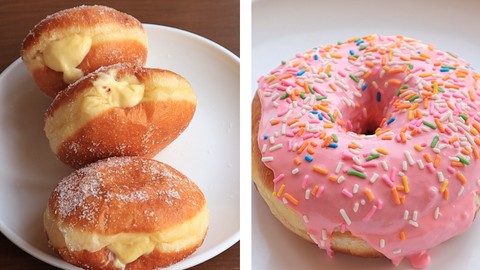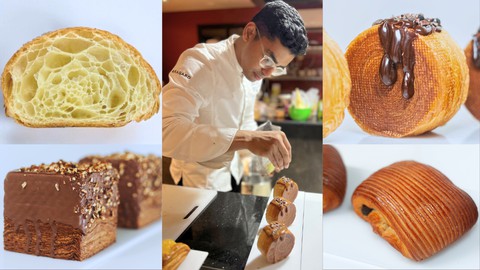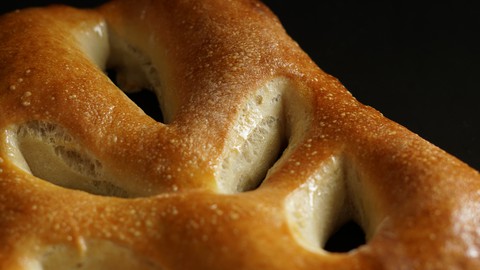What you'll learn
- 🎉 Master my prize-winning recipe for genuine Portuguese Pastel de Nata, also known as the delectable Egg Tart or Custard Tart!
- 🥐 Learn to create flaky and delicious puff pastry completely from scratch!
- 🧁 Discover the insider tricks and secrets to baking Pastel de Nata like a pro, because not all tarts are created equal!
- 👩🍳 Gain essential baking tips for achieving fantastic results right from your home kitchen!
- 🇵🇹 Explore the captivating history and intriguing stories behind Portugal's traditional pastries!
Course Content
Welcome!
1 lecturePastel de Nata. Pastel de Belém. Custard Tarts. Egg Tarts. Dàntǎ. 蛋挞. Portuguese pastries seem to be trending these days! No matter what name you associate with these smooth and custardy treats, it all started with Pastel de Nata, in Portugal.
During this course, filmed inside the kitchen of my family-run bakery in Lisbon, I will teach you how to make professional Pastéis de Nata (that's the plural of Pastel de Nata) at home, with easy to find ingredients and utensils.
If you've ever felt that puff pastry is intimidating, this is your chance to demystify the process, following this recipe, which I break down into easy steps. We will also go into what makes the puff pastry of Pastel de Nata unique, cook the most elegant of custards, and bake it all taking into consideration some simple tricks, to achieve bakery level pastries at home!
If you are a professional baker or perhaps have even made Pastel de Nata before, I will go deeper and share with you the tricks and secrets of my award-winning Portuguese pastries!
--> HEAD TO THE RESOURCES TO DOWNLOAD THE PDF WITH THE FULL RECIPE IN SEVERAL LANGUAGES!
History of Pastel de Nata
1 lectureHow did Pastel de Nata come about? There has been an evolution between previous Portuguese pastries and what we know now-a-days as Pastel de Nata. I don't mean to give you an in-depth history lesson, but knowing the origin of what you are about to bake and eat will make it all taste even better, you'll see! After all, if this is Portugal's most iconic treat, it had to have some proper history behind it...
Dough & Puff Pastry Making
2 lecturesPastel de Nata making starts similarly to a bread or pizza recipe! But, in this case, we will start the recipe making a "dead dough", that is, a dough without yeast that is not meant to rise. This is the base dough which we will eventually turn into puff pastry. If you have a dough mixer at home, I will show you how to make the most of it to achieve this part of the recipe. If you don't have a mixer, don't worry! I also show how to do it all by hand, which is actually more fun for those who literally like getting their hands "dirty"!
Puff pastry can be intimidating, even for home-bakers who may be experienced with other types of cooking techniques. Fear not! When you break it down step by step, puff pastry is fairly simple and actually fun to make.
After showing you how to make the dough, we will go into how to upgrade that dough into flaky puff pastry. In Portugal it is customary to use vegetable margarine for puff pastry, and many other cakes too. But this is no ordinary margarine! It's margarine specific for puff pastry, pastel de nata and croissant, which is locally known as margarina para folhados. It doesn't get burnt even at very high temperatures, which is super important as Pastel de Nata is baked at a high temperature so that it caramelizes as it should. Please don't use regular store bought margarine for this, the one you'd spread on toast, as the results won't be the same. If you can't get puff pastry level margarine (normally sold in establishments for the F&B industry or baking supply stores), I'd recommend using butter instead. While this recipe calls for 250 grams (8.8 oz) of margarine, the amount if using butter would be 180 grams (6.3 oz) - margarine and butter have different consistency and water content, as such, the amounts used would be different!
Custard, aka the Pastel de Nata filling
1 lectureIt's funny how Pastel de Nata literally translates into "cream tart", and the recipe includes no cream! The name came about because it is indeed creamy and, of course, milk does contain cream after all. This creaminess is what makes this pastry so great! The contrast between the flaky pastry on the outside and the smooth slightly runny custard on the inside is a delight! In this lecture, we go into how to make the custard using simple ingredients. Apart from the standard recipe for custard, I include my signature touches which are subtle but do make a difference: cinnamon stick and lemon rind. I encourage you to try out different mounts to see what you like best. In Portugal, some folks love the lemony touch, while others prefer that it's more cinnamony. It's up to you to try out different amounts and discover what you end up liking the most.
Keep in mind that there's one last step we need to make to complete the custard, after it cools down and we're ready to bake - see Lecture 7 on Section 5 to see this finishing step!
Final touches and baking
3 lecturesIf you truly want to achieve authentic looking and tasting Pastel de Nata, I urge you to get some pastry molds specific for this Portuguese pastry.
These are the standard measurements of Pastel de Nata tins:
Base: 3,5cm | 1.4 inches
Top part: 7cm | 2.7 inches
Height: 3cm | 1.2 inches
Genuine Pastel de Nata molds are inexpensive and fairly easy to source - ask me for advice and I can help you figure this out, depending where you are in the world.
In this lecture, I show you how to season your Pastel de Nata molds before their very first use. This is an important step to ensure your molds are ready to be used for a long, long time. This process guarantees perfect baking in these non-stick tins, while also optimizing the molds for your own safety.
When you go out and eat a Pastel de Nata, you can do a simple test for the quality of its crust: lift the pastry and inspect the bottom. The puff pastry laminations should appear as a spiral - this clearly shows that the baker knew the right technique for Pastel de Nata. During this lecture, I show you how to spread the puff pastry on the Pastel de Nata molds in this signature way, for maximum flakiness and crispy results. We also go over the last finishing touches for the custard and how to assemble your pastries before they finally go into the oven.
Pastel de Nata is baked at very high temperatures, allowing for the top layer of the custard to caramelize, while the puff pastry around it gets beautifully golden. Many people, even here in Portugal, think home ovens won't be good enough for this, but this is actually not true! I teach you how to use your home oven to bake perfect pastries. But because all ovens are different, it wouldn't be enough to say how many minutes you have to bake your pastries for. Instead, I show you how to know when they are done!
Final (and best!) step: Tasting!
3 lecturesWe couldn't end this course without tasting at least one Pastel de Nata together, right? I show you how to easily unmold the pastries when you use the original Pastel de Nata tins.
As a good Portuguese, I couldn't resist sharing my favorite pastries with you, telling you how to elevate the tasting experience using powdered cinnamon and even recommending some drink pairings that go great with your Pastel de Nata.
Thank you very much for joining this Pastel de Nata Course. I truly hope you have fun baking at home, and I am very positive that with time, a little patience, and lots of positive vibes you will accomplish incredible results. I hope you get to travel to Portugal one day, and you come visit me at my bakery, Pastelaria Batalha. Who knows, we could maybe even do a Pastel de Nata competition? I'm sure you'll do great! ;) Keep baking and having fun in the kitchen. Obrigado!
Final notes regarding completing this course. Ask me anything about the recipe, ingredients and where to find original Pastel de Nata molds. Well-done for getting here! :)
If you enjoyed this course, I'd love to invite you to check out my most recent courses on Udemy, dedicated to Portuguese Christmas specialties:
- Bolo Rei (King's Cake) and Bolo Rainha (Queen's Cake)
- Portuguese Christmas Desserts (Rabanadas, Sonhos de Natal, Filhós, Coscorões and Azevias).
Description
Pastel de Nata is the crown jewel of Portugal's desserts! 🇵🇹 Known worldwide as Pastéis de Belém, Egg Tart (dàntǎ) in Asia, and Custard Tarts globally, these flaky treasures filled with creamy custard are irresistible. After this course, you'll master the authentic Pastel de Nata and distinguish it from other custard or egg tarts you might have encountered outside of Portugal. 🥧✨
*** Course videos are in English but come with subtitles and downloadable recipes in English, Spanish, Portuguese, French, German, Italian, Korean, Arabic, Chinese Mandarin, Japanese, and Russian. ***
We'll guide you through every step in an easy-to-follow manner, revealing secrets to creating bakery-quality pastries just like those found in Portugal's charming pastry shops. 🏆 Discover tips for perfecting your dough alongside creative twists for the custard, achieving the perfect balance of flavors and textures.
Dreaming of recreating the Pastel de Nata from your favorite Portuguese café at home? 🏠 This course is your ticket! And if you're a professional baker ready to introduce authentic custard tarts to your menu, gain invaluable insights from our expert tips. Welcome to a delicious journey! Obrigado! 😊
Who this course is for:
- Home bakers and baking enthusiasts 🍰
- Professional bakers 🥐
- Lovers of Portuguese food ❤️🥘
Course Reviews
-
😀 Margarita Manzke
-
😀 Yen Nguyen
-
😀 Rebecca Olsson
-
😀 George Vega
-
😀 Pedro Silva
-
😀 Luisa Cristina Mendiola Solari
The course is very illustrating
-
😀 Loza Gebrehiwot
-
😀 Chris hook
-
😀 Jessie Huang
-
😀 Lourenda naude
-
😀 Sobyungwook
-
😀 손화진
-
😀 Jiae Song
-
😀 Michael Ring
-
😀 Raul Silva Dias de Oliveira
-
😀 Boaventura dos Santos Antonio Filho
-
😀 Cheryll Vejano
-
😀 Eli Dunn
-
😀 Andre Dobridnik
-
😀 Mihaly Nagy
-
😀 Maritza Cubero R
-
😀 Nuno teixeira
-
😀 Pedro Emanuel Delgado Duarte
-
😀 Andréia Kaori Io Imai Gomes
-
😀 Marcia
-
😀 Olga Zara
-
😀 Fatima Shahid
-
😀 Jarmila Majerová
-
😀 Vince Gervasi
-
😀 Emily Vann Green
I haven't finished taking this course but so far, it's really amazing. I love the attention to detail that chef uses and how he is breaking down the information. I'm Portuguese-American and have always wanted to learn how to make pastel de nata. Can't wait to finish the course and make these for my family! :)
-
😀 Paulette Karam
The chef makes it look so easy to do ;)
-
😀 Leonard Galatanu
-
😀 Franco Emanuel Vercellino
Para ser perfecto debería tener una una receta con ficha técnica
-
😀 Paweł P.
-
😀 Suchanya Piyamaporn
-
😀 Rebekah Taylor
-
😀 Elisabeth Ferreira do Nascimento
-
😀 Юлия Абентова
Курс очень хороший все понятно.спасибо
-
😀 Jean-Louis Mondon
-
😀 Luis
Thank you Joao
-
😀 Aisha
-
😀 Sujin Lee
-
😀 Ivan Miguel da Conceição Micas Sitoe
-
😀 Nang Su
-
😀 İdil Akbaba
-
😀 Mia Alberti
-
😀 Ayad Mhamood
-
😀 성건창
-
😀 허지환
-
😀 Anna May T. Rivera
-
😀 Ima shazira binti ishak
-
😀 Adas Amer
-
😀 Stefanescu Andreea
-
😀 Trucly Nguyen
-
😀 J Ossea
-
😀 Barbara
Easy to follow and straight to the point. Great explanation of why things are done a certain way.
-
😀 Karen Saunders
-
😀 María Rivera
-
😀 Odile Sule
-
😀 Cristina
-
😀 Julie Cockburn
The recipe and techniques were well explained, and Joao is both engaging and entertaining. The only thing keeping me from giving it a full 5 stars is that I wish the course also included instructions on how to make the pastries with butter rather than pastry margarine. The included PDF recipe does give an option for butter, but it would have been nice to see the difference in techniques from one fat to the other.
-
😀 Maria Margarida Abreu
-
😀 Paulo Jorge Martins Santos
So tenho pena que não seja em português
-
😀 Zehra Ustaoglu
-
😀 Anisa Abdullahi
-
😀 Christine McGlashan
I want to learn every aspect of making these tarts
-
😀 Enes Çiftci
it was an instructive and fast experience, It was a pastry that I wanted to learn for a long time, I first tasted it in Berlin. Now I can do it at home alone
-
😀 John Silbert
-
😀 Gijs Elst
-
😀 Laila Mahmoud
-
😀 James J Long
-
😀 Fernando Cruz
-
😀 Marisa Heah Tsui Ying
-
😀 Michi
-
😀 Robert Allan
-
😀 Muhammad Asif
so easy to follow but only thing i found to get magarine here locally.
-
😀 Carlo F. Magno
-
😀 Malik Khoja
-
😀 Abrar Ismail
-
😀 Natasha Maximo-Constandinou
-
😀 Jane Cruz
Very interesting course and well explained. At the end of the course you will definitely crave and encourage to bake one for yourself!
-
😀 Ferdinand Mendoza
-
😀 Thais Quaresma
-
😀 Gabriela
😍
-
😀 Simon Tilton
-
😀 Hilary King
-
😀 Kata Szemerey
-
😀 Aleksander
-
😀 Ramir De Castro
-
😀 Lionel
-
😀 양세원
-
😀 Alexandra Raquel Martins Duarte Respen
Gostei muito da forma simples que o Joao ensina.
-
😀 Rookmeenee Seesurn
-
😀 윤용호
-
😐 Angela Troup
-
😀 Jeremy Loveland
-
😀 Hazel Bandala
-
😀 Nora Rocca Righton
Sí, hasta aquí muy buena.
-
😀 지츄 김
-
😀 Seo yoon

